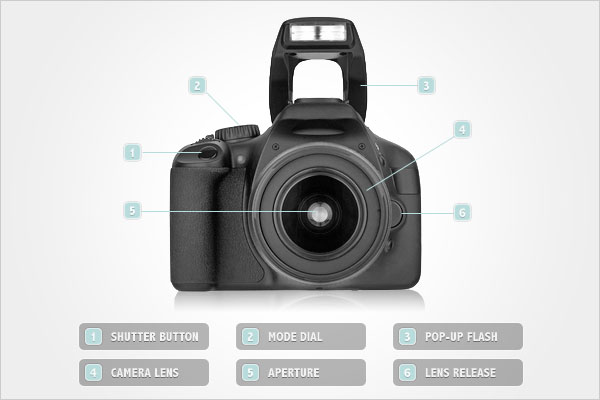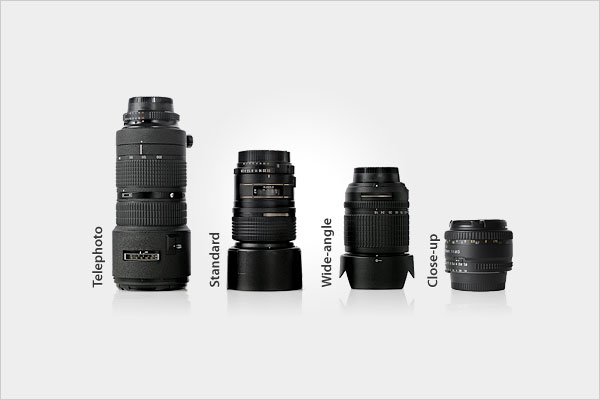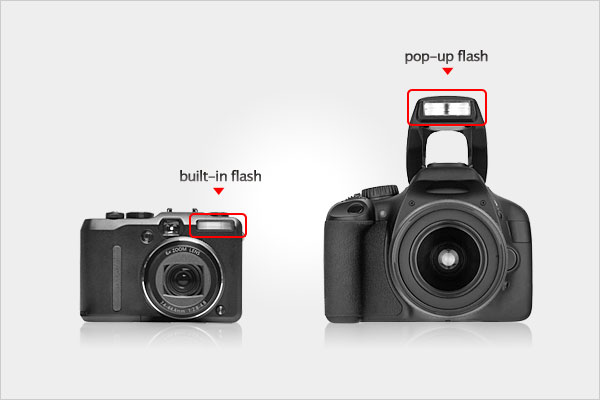Learn the Basics of Your Digital SLR Camera
- Camera Controls -
- Image Sensor -
Since the dawn of photography, cameras have captured and stored images on glass plates or on film. Today, digital cameras capture the images on a nifty piece of technology – the image sensor. The image sensor is made up of millions of light sensitive photodiodes set on a grid, where each photodiode records a tiny portion of the image as a numeric value that corresponds to a specific brightness level, which is then used to create your image. Image sensors, whether they are CCD or CMOS, vary from camera to camera but they’re basically the same, and the megapixel count shouldn’t be a priority in the decision-making process when buying a camera. Why? Because the size of the sensor is actually more important that the number of megapixels.
- Camera Lens -
A lens is an optical component made out of glass, high quality plastic, or ceramic, which captures the light and assembles it on a point of focus at the matte screen passing through a condensing lens inside the camera. If you are looking for ease of handling, you can go for point-and-shoot cameras with fixed lenses. However if you are concerned about picture quality, you should invest in a digital SLR (DSLR) camera with interchangeable lenses. Interchangeable lenses allow you to have much more control of your images, and to be far more creative than you can be with a point-and-shoot camera. All in all, DSLR cameras produce a more professional photograph.
- Camera Modes -
DSLR cameras are equipped with a variety of shooting modes that increase the automatic decision making of the camera. These cameras, thankfully, have semi-automatic and manual modes too, which put the control back in your hands for more technical and creative applications. In PROGRAM mode, the camera sets the exposure, but the user can adjust the white balance, ISO, focusing and metering. There are two semi-automatic modes: 1) Shutter Priority (Tv) is where the user sets the shutter speed and the camera determines the aperture. Shutter Priority allows the user to control how “the action” is captured. 2) Aperture Priority (Av) where the user selects the aperture and the camera determines the shutter speed. Aperture Priority allows the user to control the depth-of-field.
- Built-in Flash -
A built-in flash is provided with every digital camera. The camera’s computer determines need for flash according to the exposure metering, focusing and zoom systems. On compact cameras the built-in flash is triggered to go off in perfect sync with the shutter, but it’s hard to control the timing and intensity of the flash. This can result in washed-out photos. DSLRs have pop-up flashes that can be controlled in various ways to be in-sync with the shutter or drag behind the shutter; in addition the intensity can be manipulated in accordance to the overall light of the scene. DSLR cameras allow for more pleasing and artistic use of the flash.
- Viewing System -
Most digital cameras have two viewing systems – the optical viewfinder and the electronic viewfinder. While both systems show you what the lens sees, the electronic viewfinder can tell you other things about the nature of your digital image. One area where the electronic viewfinder is superior is in determining color balance. The electronic viewfinder can show where the highlights are overexposing (and if you’ll need to compensate). What is great is that you’ll see this in real-time. The optical viewfinder puts you directly inside the mechanical world of the camera, and tends to perhaps give you a better sense of the composition because you’re seeing exactly what the lens is seeing, not an electronic approximation.
LIKE N UPVOTE MY POST







Hi! I am a robot. I just upvoted you! I found similar content that readers might be interested in:
https://www.exposureguide.com/camera-controls/
thank you for upvote my post
Congratulations! This post has been upvoted from the communal account, @minnowsupport, by dikki from the Minnow Support Project. It's a witness project run by aggroed, ausbitbank, teamsteem, theprophet0, someguy123, neoxian, followbtcnews/crimsonclad, and netuoso. The goal is to help Steemit grow by supporting Minnows and creating a social network. Please find us in the Peace, Abundance, and Liberty Network (PALnet) Discord Channel. It's a completely public and open space to all members of the Steemit community who voluntarily choose to be there.
If you would like to delegate to the Minnow Support Project you can do so by clicking on the following links: 50SP, 100SP, 250SP, 500SP, 1000SP, 5000SP. Be sure to leave at least 50SP undelegated on your account.
thank you
This post has received a 0.31 % upvote from @drotto thanks to: @banjo.
thank you